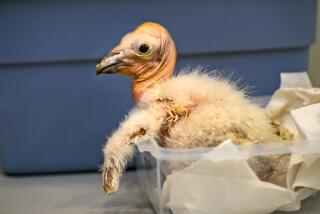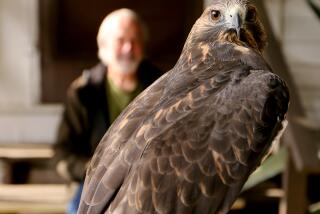Hope Fades for Species : An Intensive Effort Failed to Save Condor From Poison
For 15 days a team of veterinarians at the San Diego Wild Animal Park labored around the clock against mounting odds to save the life of AC-3, the last female California condor in a breeding pair and something of a celebrity in wildlife conservation circles.
But shortly after noon Saturday, the rare bird died, poisoned by lead shot embedded in a carcass she had eaten. Her illness and death have left authorities anticipating a barren breeding season, and “humbled” by the experience of watching her go.
“At the risk of being anthropomorphic, and all of us science types hate to be anthropomorphic, the bottom line is she is stoic. She’s tough,” Bill Toone, assistant curator of birds for the Zoological Society of San Diego, had said during the big bird’s last days last week.
“People keep telling us the condors are at the end of their evolutionary road, that they’re weak,” said Toone, a condor specialist. “Horsepucky. The bottom line is that nothing has really changed in these birds. They are tough, they are strong.
“She has maintained so much dignity through this by just being calm and lucid. It’s just tragic to have to deal with it. Working with them in general is a very humbling experience.”
The demise of AC-3, so named because she was the third adult condor identified in a radio-tagging operation, leaves only 26 remaining California condors. Bald, black creatures with a 10-foot wing span, they are among the largest flying birds in the world.
At one time, they ranged over nearly all of western North America and as far east as Florida. Victimized by loss of habitat and the spread of pesticides, poisons and lead shot, only five remain in the wild, and 21 in San Diego’s Wild Animal Park and the Los Angeles Zoo.
None are currently in breeding pairs, though some have produced offspring in the past. During the last breeding season, there were five pairs. But seven wild condors died of lead poisoning and other causes that winter, including members of four of those pairs.
That left only AC-3 and her mate, which authorities said last week continues to fly above the condor habitat in Kern County. Three of AC-3’s eggs had been hatched in captivity. Her offspring include the young condors Kaueah and Malibu at the Los Angeles Zoo.
“This is a bird that is very, very well-known to all of us,” said Toone, noting that she stars in an upcoming National Audubon Society film on condors. “ . . . Being the last remaining female of a breeding pair in the wild, it’s a bird we have been watching closely.”
Authorities had noticed listlessness, disorientation and other signs of lead poisoning in AC-3 during a tagging expedition in November. But by the time they had government approval to capture her Jan. 3, the lead in her blood had reached lethal levels.
She spent most of her last 15 days in a small, windowless room at the Wild Animal Park; the room was lit by a skylight, bedded with straw, and kept at a temperature of 85 degrees, Toone said. Specialists watched her 24 hours a day from behind mirrored, one-way glass.
Much of the time, the bird simply lay on her side, said Tom Hanscom, a spokesman for the park. Meanwhile the vets conferred by telephone with condor experts across the country, and Hanscom delivered dispatches from the front.
“She behaved a bit more vigorously,” he reported one day last week after the bird was taken to a larger area for some fresh air. “However, we have her in that same quarantine facility today, and she is extremely depressed.”
“These are uncharted waters,” he explained. “Nobody’s ever watched a condor starve.”
At first, Toone said, the vets’ approach was conservative: use anti-lead medication to lower the lead levels in the blood. Then perhaps her other bodily functions would return to normal, in particular her digestive system, which had been crippled by the lead.
Lead poisoning damages the myelin that protects the nerves, making it impossible to convey nerve impulses to the muscle responsible for involuntary actions like digestion. Eventually, Toone said, it also damages balance and respiration.
The medication brought the lead levels down--from 4.2 parts per million to 1.4. But the bird’s digestive system apparently never recovered, in spite of a series of heroic measures taken over the past week.
The vets first tried feeding the bird “a finely blended mouse mixture”--minced day-old mice and egg yoke. When that failed, they forced her to regurgitate it and tried a liquid mixture. But that also went nowhere.
By late Monday, the vets found the bird weakening. She appeared increasingly lethargic and unresponsive. Too weak to resist, she was placed on intravenous feeding in hopes of raising her strength for more drastic measures.
The following day, the vets put her under anesthesia and inserted a tiny microscope called an endoscope into her digestive tract. Hoping to find a blockage, they probed the canal. But they found it apparently normal.
“The bird is in an extremely depressed condition now,” Toone reported after the procedure. “ . . . She is at this point beginning to lose her balance as a result of low nutritional status.”
Things went downhill after that.
After the endoscopy, the vets placed a radio-opaque fluid in the gastrointestinal tract, X-rayed for movement, and found none. Later, they tried giving her food again, only to have to mix it with water and siphon it off when it failed to move through her system.
“At this point, all signs point to simply a sustained paralysis,” Hanscom said. “So it’s up to the bird.”
Finally, on Saturday, AC-3 underwent surgery--an option the vets had resisted for fear that the trauma would kill her. They inserted a tube running from her neck to the lower portions of her digestive tract, bypassing the paralyzed upper sections.
But the bird reacted badly to the tube, pecking at it with her beak and trying to remove it. She spent her last moments struggling. Then, shortly before 1 p.m., she died.
The condor’s death heightens the legal battle between the zoos and the National Audubon Society over the best way to preserve the species. Last week, a federal judge temporarily barred the capture of the remaining birds at the request of the Audubon Society, which wants the federal government to buy up and protect the birds’ habitat.
“Who do I blame? . . . I guess I blame our system,” Toone said sadly. “Last March, the (condor) working group suggested bringing in the last six birds and this (lead-poisoning) problem was sited specifically. And here we are, because people said they wanted condors out there. I’m just tired of looking at dead condors.”
More to Read
Sign up for Essential California
The most important California stories and recommendations in your inbox every morning.
You may occasionally receive promotional content from the Los Angeles Times.










